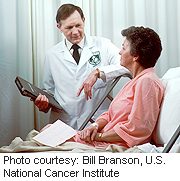
MONDAY, May 12, 2014 (HealthDay News) — A new study finds that cervical cancer rates in the United States are much higher than previously reported, especially among women in their 60s and black women.
Previous studies had estimated that the U.S. cervical cancer rate was about 12 cases per 100,000 women, that the highest rates were in women between ages 40 and 44 and that they then leveled off.
But those estimates included women who had hysterectomies, in which the cervix was removed. For the new study, researchers excluded this group of women, because they were no longer at risk, and then concluded that the overall rate of cervical cancer was 18.6 cases per 100,000 women. They also found that the incidence rose steadily with age and peaked at ages 65 to 69.
The incidence of cervical cancer among women ages 65 to 69 was 84 percent higher than previously reported, according to the study, published online May 12 in the journal Cancer.
“Our corrected calculations show that women just past 65, when current guidelines state that screenings can stop for many women, have the highest rate of cervical cancer,” study lead author Anne Rositch, an assistant professor of epidemiology and public health at the University of Maryland School of Medicine, said in a university news release.
The current rate among white women ages 65 to 69 was less than half what it was for black women of the same age. Black women had higher cervical cancer rates at nearly all ages than white women, and this difference was greatest among older women.
“The higher rates of cervical cancer after correction for hysterectomy highlight the fact that, although a large proportion of cervical cancer has been prevented through early detection and treatment, it remains a significant problem,” the researchers wrote.
They noted that current U.S. cervical cancer screening guidelines do not recommended routine Pap smears for women older than 65 who have had normal findings on previous tests.
“It will be important to consider these findings when reevaluating risk and screening guidelines for cervical cancer in older women and the appropriate age to stop screening,” added Rositch, a researcher at the University of Maryland Cancer Center.
She also said future studies need to determine “whether the continued increase in cervical cancer rates with age and the higher rates in African-American women represent a failure in our screening programs or a failure of the women to be screened so that appropriate interventions can be applied.”
Because the human papillomavirus (HPV) is responsible for almost all cervical cancers, the researchers also stressed the need for greater use of the HPV vaccine.
More information
The American Cancer Society has more about cervical cancer.
Copyright © 2025 HealthDay. All rights reserved.

